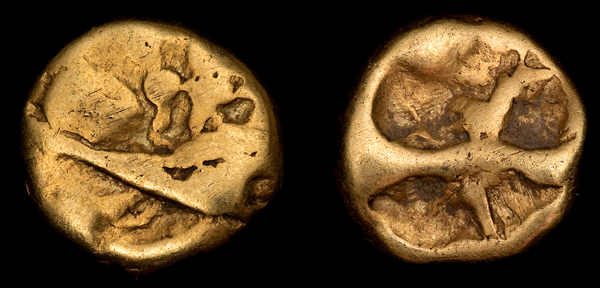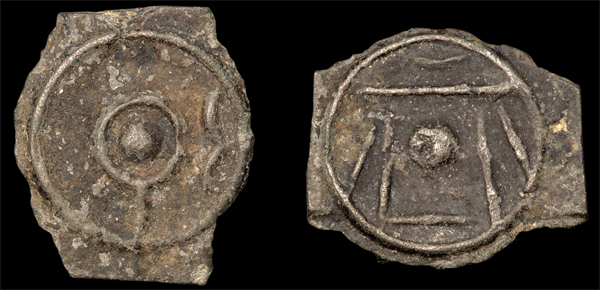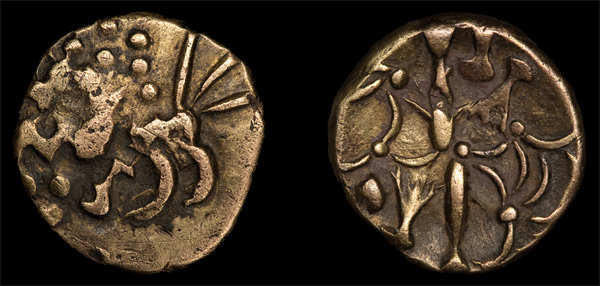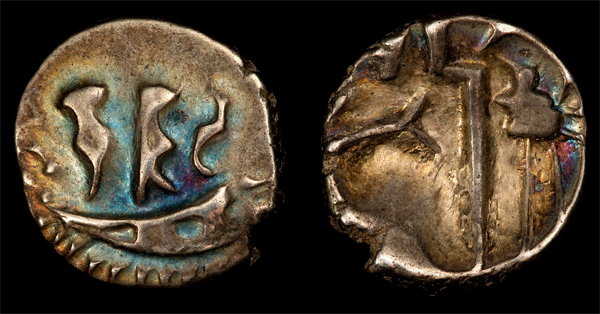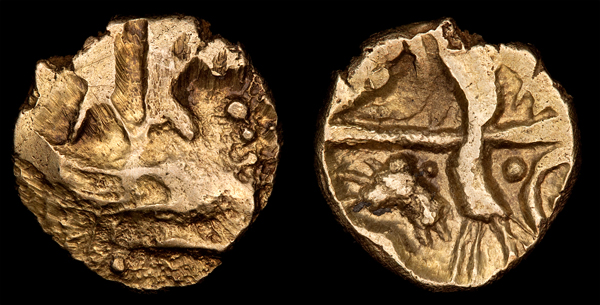Despite the fact that the first Horse Geometric (previously Bearded Head) quarter stater was sold in 1993, you still won’t find it 27 years later in any reference books. Cutting a long story short, it appears that the original finder(s) lied about the findspot to hide an undeclared hoard. This, along with the highly unusual obverse design (it was initially thought to be a bearded head), the paucity of dies, and some other factors, has led some to doubt the authenticity of the coins.
If the coins are fake then we would hope to find some evidence of that on the coins themselves, but even as late as 2018, a meeting between Chris Rudd Ltd., Dr. Philip de Jersey, and Dr. John Sills, failed to reach a conclusion. Stated another way, in the quarter of a century after the first coin was sold, the premier experts in the field, along with other respected dealers who have sold these coins, have been unable to identify anything that condemns any of the coins. Despite a detailed analysis of the coins individually and as a group, it appears that there is nothing actually wrong with them.
Horse Geometric quarter staters have been found in recent years by metal detectorists who are not all known to each other and have no connection to the original finders. Additionally, all of the arguments I know of (apart from one) which have been used to cast doubt on them have been refuted and can be ignored. For example:
- the argument that they all come from the same reverse die fails because one of the coins was struck by a different reverse die
- the argument that they are “curiously well centred” fails when the displacement of the die centre from the flan centre is measured. It turns out that these coins have worse centring than another quarter stater type that is known to be genuine
- the argument that no one will record them with PAS (Portable Antiquities Scheme) is no longer true as two are now recorded. More would be recorded, but as the finder of mine said “it would just be marked as authenticity uncertain so there is no point sending it to them”
Other arguments have been made, but the ones above are the strongest ones. The remaining point of doubt is that the orginal coins were found around the same time (early 1990s) as a group of fake Cheriton Smiler staters which were possibly copied from real finds (I haven’t been able to confirm the details). It’s possible that the original Horse Geometric finders did something similar, but that only allows doubt to be cast on some of the original coins. Ones found in recent years by independent detectorists can be assumed to be genuine.
The coins were originally named “Bearded Head” because of the abstract bearded head that appears on the obverse. However, this appears to have been an optical illusion caused by circulation and die wear on the coin sold by Chris Rudd who named the type. There’s very little on the obverse to suggest that this is a head, and the standard hair bar, wreath, hair locks, hair curls, and face are all missing. I have been unable to see a head on any of the coins apart from the original Chris Rudd coin (it is very clear on that coin).
Another interpretation of the obverse exists if the coin is rotated 90 degrees anti-clockwise. In this orientation an abstract horse with one of its forelegs raised can be seen. While it is certainly strange to have a horse on the obverse of a gold Celtic coin rather than Apollo’s head, we can consider this as an experiment that didn’t lead anywhere. After all, the “two men in a boat” quarters don’t follow the traditional Apollo’s Head iconography, and if you subscribe to the argument that the boat should be rotated and be described as an “abstract beast”, then that certainly doesn’t follow the traditional iconography either (and it provides an opening for an abstract horse). Neither do many other types. The British C Yarmouth stater shows definite experimentation, and later coins dispensed with Apollo’s head altogether. The Huxtable’s Eagles quarter stater (ABC 782) is particularly interesting as it has two horse heads, two eagles, and a pellet infill on the obverse.
The reverse of the coin shows an intricate rendering of the standard “geometric” designs that derive from GB-Ca2 quarters. Quite what it represented is unknown, but someone (a trawlerman) who saw it said straight away that it was a fisherman’s catch. There is a theory that quarters staters were used to pay sailors and staters used to pay soldiers, so a fishing theme would fit nicely with that, especially if the GB-Ca2 quarters (and their derivatives) do show two men in a boat on the obverse.
The metal content of the one coin analysed is 24.8% gold, 44.5% silver, and 30.4% copper, which suggests that this is the companion quarter to the British C Yarmouth stater (see 101), which is 28.9% gold, 47.4% silver, and 23.6% copper. They are found in the same areas, and the Yarmouth stater is renowned for being visually “weird”. Until further information comes to light, I’ll consider this to be British C2 and a product of the Regini tribe, or whoever minted the Yarmouth staters.
For more information on these coins, see Bearded Head Quarter Staters - Fact or Fiction.

